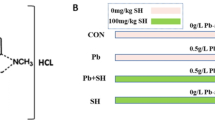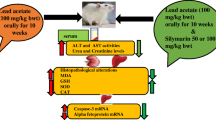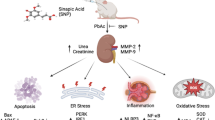Abstract
Lead has heavy metal toxicity which endangers human and animal health. Salidroside (SDS) is a natural antioxidant that has extensive pharmacological usage. However, its protective effects on lead-induced oxidative stress and hepatotoxicity has not been reported. In this study, we established an animal model to evaluate the protective effects of SDS on chronic lead exposure induced oxidative stress and hepatotoxicity. Forty healthy Sprague-Dawley (SD) rats were assigned to control group (control, animals were provided with distilled water, n = 10); lead acetate-exposed group (PbAc, animals received lead acetate solution of 500 ppm for 60 days, n = 10); low dosage of SDS-treated group (PbAc-SDS-L, lead acetate exposed animals were given intragastric SDS 150 mg/kg body weight for 60 days, n = 10); and high dosage of SDS-treated group (PbAc-SDS-H, lead acetate exposed animals were given intragastric SDS 300 mg/kg body weight for 60 days, n = 10). The results showed that lead exposure caused a significant increase in serum ALP, AST, ALT, and TB (P < 0.01), and these were reversed after treatment with salidroside for 60 days. Compared to the control, the liver GSH, SOD, and GSH-Px were decreased significantly after lead acetate exposure (P < 0.01). However, after treatment with SDS for 60 days, those were dose-dependently reversed. Similarly, MDA was significantly increased in the PbAc group (P < 0.01), and it was significantly decreased in SDS treatment group. Moreover, SDS ameliorated lead-induced congestion and necrosis of hepatocytes. In addition, the RT-PCR and immunohistochemistry results revealed that the PbAc group showed a significant increase in the protein and mRNA of cytochrome P450 2E1 (CYP2E1) and NADPH oxidase 2 (NOX2) in rat liver. Treatment with SDS significantly reversed CYP2E1 and NOX2 expressions in the liver of lead-exposed rats. The results above indicated that SDS has obvious antioxidant activity; it can cure liver injury caused by lead acetate by inhibiting oxidative stress and increasing the antioxidant stress activity, thus improving the liver tissue structure.









Similar content being viewed by others
References
Goyer RA (1993) Lead toxicity: current concerns. Environ Health Perspect 100(4):177–187
Obeng-Gyasi E, Armijos R, Weigel M, Filippelli G, Sayegh M (2018) Cardiovascular-related outcomes in U.S. adults exposed to lead. Int J Environ Res Public Health 15(4):759–769
Qi S, Zheng H, Chen C et al (2019) Du-Zhong (Eucommia ulmoides Oliv.) cortex extract alleviates lead acetate-induced bone loss in rats. Biol Trace Elem Res 187(1):172-180
Sharma A, Sharma V, Kansal L (2010) Amelioration of lead-induced hepatotoxicity by Allium sativum extracts in Swiss albino mice. Libyan J Med 5(5):4621–4627
Ommati M M, Jamshidzadeh A, Heidari R et al (2018) Carnosine and histidine supplementation blunt lead-induced reproductive toxicity through antioxidative and mitochondria-dependent mechanisms. Biol Trace Elem Res 187(1):151-160
Kwon SY, Chung JH (2016) Erythrophagocytosis of lead-exposed erythrocytes by renal tubular cells may contribute to lead-induced nephrotoxicity. Toxicol Lett 259:S239–S239
Berrahal AA, Lasram M, Kerkeni A et al (2015) Effect of age-dependent exposure to lead on hepatotoxicity and nephrotoxicity in male rats. Environ Toxicol 26(1):68–78
Hsu PC, Guo YL (2002) Antioxidant nutrients and lead toxicity. Toxicology 180(1):33–44
Liu B, Jiang H, Lu J, Baiyun R, Li S, Lv Y, Li D, Wu H, Zhang Z (2018) Grape seed procyanidin extract ameliorates lead-induced liver injury via miRNA153 and AKT/GSK -3β /Fyn -mediated Nrf2 activation. J Nutr Biochem 52:115–123
Dobrakowski M, Pawlas N, Kasperczyk A et al (2016) Oxidative DNA damage and oxidative stress in lead-exposed workers. Hum Exp Toxicol 36(7):744–754
Aruoma OI (1998) Free radicals, oxidative stress, and antioxidants in human health and disease. J Am Oil Chem Soc 75(2):199–212
Ercal N, Gurerorhan H, Aykinburns N (2001) Toxic metals and oxidative stress part i: mechanisms involved in metal-induced oxidative damage. Curr Top Med Chem 6:529–539
Li Z, Yu H, Zhao X et al (2010) Neuroprotective effects of salidroside against beta-amyloid-induced oxidative stress in SH-SY5Y human neuroblastoma cells. Neurochem Int 57(5):547–555
Li F, Tang H, Xiao F, Gong J, Peng Y, Meng X (2011) Protective effect of salidroside from rhodiolae radix on diabetes-induced oxidative stress in mice. Molecules 16(12):9912–9924
Guo Y, Zheng C, Xu W, Si Y, Dou S, Yang Y (2013) Free radical scavenging and hepatoprotective effects of salidroside analogs on CCl4-induced cytotoxicity in LO2 cells. Med Chem Res 22(5):2524–2530
Yang Z, Wang H, Zuo T, Guan LL, Dai N (2016) Salidroside alleviates oxidative stress in the liver with non-alcoholic steatohepatitis in rats. BMC Pharm Toxicol 17(1):16–22
Szkoda J, Zmudzki J (2005) Determination of lead and cadmium in biological material by graphite furnace atomic absorption spectrometry method. Bull Vet Inst Pulawy 49:89–92
Lin YL, Lin HW, Chen YC, Yang DJ, Li CC, Chang YY (2017) Hepatoprotective effects of naturally fermented noni juice against thioacetamide-induced liver fibrosis in rats. J Chin Med Assoc 80(4):212–221
Zhong Z, Han J, Zhang J, Xiao Q, Hu J, Chen L (2018) Pharmacological activities, mechanisms of action, and safety of salidroside in the central nervous system. Drug Des Dev Ther 12:1479–1489
Zhu J, Wan X, Zhu Y, Ma X, Zheng Y, Zhang T (2010) Evaluation of salidroside in vitro and in vivo genotoxicity. Drug Chem Toxicol 33(2):220–226
Heim KE, Tagliaferro AR, Bobilya DJ (2002) Flavonoid antioxidants: chemistry, metabolism and structure-activity relationships. J Nutr Biochem 13:572–584
Sharma V, Kansal L, Sharma A (2010) Prophylactic efficacy of Coriandrum sativum (coriander) on testis of lead-exposed mice. Biol Trace Elem Res 36:337–354
Imafidon CE, Olukiran OS, Ogundipe DJ, Eluwole AO, Adekunle IA, Oke GO (2018) Acetonic extract of Vernonia amygdalina (Del.) attenuates cd-induced liver injury: potential application in adjuvant heavy metal therapy. Toxicol Rep 5:324–332
Jia YN, Lu HP, Peng YL, Zhang BS, Gong XB, Su J, Zhou Y, Pan MH, Xu L (2018) Oxyresveratrol prevents lipopolysaccharide/d-galactosamine-induced acute liver injury in mice. Int Immunopharmacol 56:105–112
Brodkin C, Moon J, Camp J et al (2001) Serum hepatic biochemical activity in two populations of workers exposed to styrene. Occup Environ Med 58(2):95–102
Abdel-Moneim AE, Dkhil MA, Al-Quraishy S (2011) The redox status in rats treated with flaxseed oil and lead-induced hepatotoxicity. Biol Trace Elem Res 143(1):457–467
Abdou HM, Hassan MA (2014) Protective role of omega-3 polyunsaturated fatty acid against lead acetate-induced toxicity in liver and kidney of female rats. Biomed Res Int 2014(6):435–857
Lin Y, Li Y, Hu X et al (2018) The hepatoprotective role of reduced glutathione and its underlying mechanism in oxaliplatin-induced acute liver injury. Oncol Lett 15(2):2266–2272
Attia M (2013) Antioxidant effects of ginger (Zingiber officinale roscoe) against lead acetate-induced hepatotoxicity in rats. Afr J Pharm Pharmacol 7(20):1213–1219
Liu CM, Ma JQ, Sun YZ (2011) Protective role of puerarin on lead-induced alterations of the hepatic glutathione antioxidant system and hyperlipidemia in rats. Food Chem Toxicol 49(12):3119–3127
Tokumoto M, Lee JY, Shimada A, Tohyama C, Satoh M (2018) Glutathione has a more important role than metallothionein-I/II against inorganic mercury-induced acute renal toxicity. J Toxicol Sci 43(4):275–280
Pilarczyk B, Drozd R, Pilarczyk R, Tomza-Marciniak A, Jankowiak D, Hendzel D, Kuba J, Kowalska J (2011) Glutathione peroxidase (GSHPx) activity in the liver of red deer in relation to hepatic selenium concentrations, sex, body weight and season of the year. Biol Trace Elem Res 144(1–3):560–569
Senapati SK, Dey S, Dwivedi SK, Swarup D (2001) Effect of garlic (Allium sativum L.) extract on tissue lead level in rats. J Ethnopharmacol 76(3):229–232
Newairy AA, Abdou HM (2009) Protective role of flax lignans against lead acetate induced oxidative damage and hyperlipidemia in rats. Food Chem Toxicol 47(4):813–818
Guo Y (2010) Synthesis, biological activity of salidroside and its analogues. Chem Pharm Bull 12:1627–1629
Hasanein P, Ghafari-Vahed M, Khodadadi I (2017) Effects of isoquinoline alkaloid berberine on lipid peroxidation, antioxidant defense system, and liver damage induced by lead acetate in rats. Redox Rep 22(1):42–50
Martikainen LE, Rahnasto-Rilla M, Neshybova S, Lahtela-Kakkonen M, Raunio H, Juvonen RO (2012) Interactions of inhibitor molecules with the human CYP2E1 enzyme active site. Eur J Pharm Sci 47(5):996–1005
You Y, Min S, Lee YH, Hwang K, Jun W (2017) Hepatoprotective effect of 10% ethanolic extract from Curdrania tricuspidata leaves against ethanol-induced oxidative stress through suppression of CYP2E1. Food Chem Toxicol 108:298–304
Haddad P, Dussault SJ (2009) NOX2-containing nadph oxidase deficiency confers protection from hindlimb ischemia in conditions of increased oxidative stress. Arterioscler Throm Vasc 29(10):1522–1533
Ben MD, Polimeni L, Carnevale R et al (2014) NOX2–generated oxidative stress is associated with severity of ultrasound liver steatosis in patients with non-alcoholic fatty liver disease. BMC Gastroenterol 14(1):1–8
Acknowledgments
The authors received funding from the High-end Foreign Experts Recruitment Programme of State Administration of Foreign Experts Affairs (GDT20186100426), Shaanxi Province Key Research and Development Plan (2017SF-074), Qinling-Bashan Mountains Bioresources Comprehensive Development Collaborative Innovation Center Research Funds (QBXT-17-9), the key Project of Agricultural Science and Technology of Shaanxi Province (2017NY-082), and Postdoctoral Program in Shaanxi University of Technology (SLGBH16-03).
Author information
Authors and Affiliations
Corresponding authors
Ethics declarations
Conflicts of Interest
The authors declare that they have no conflict of interest.
Additional information
Publisher’s Note
Springer Nature remains neutral with regard to jurisdictional claims in published maps and institutional affiliations.
Rights and permissions
About this article
Cite this article
Chen, C., Lin, B., Qi, S. et al. Protective Effects of Salidroside on Lead Acetate-induced Oxidative Stress and Hepatotoxicity in Sprague-Dawley Rats. Biol Trace Elem Res 191, 426–434 (2019). https://doi.org/10.1007/s12011-019-1635-8
Received:
Accepted:
Published:
Issue Date:
DOI: https://doi.org/10.1007/s12011-019-1635-8




